Study on the Accessibility and Recreational Development Potential of Lakeside Areas Based on Bike-Sharing Big Data Taking Wuhan City as an Example
Abstract
1. Introduction
2. Materials and Methods
2.1. Study Area
2.2. Data Source
2.2.1. Wuhan Lake Data
2.2.2. Mobike Data
2.3. Method
2.3.1. Chord Diagram
2.3.2. Kernel Density Estimation
2.3.3. Accessibility Possibility Model
3. Results
3.1. Overall Spatial and Temporal Characteristics
3.1.1. Overall Timing Characteristics
3.1.2. Spatial OD Relationship
3.2. OD Time Series Characteristics of Lakes
3.3. Wuhan Lakeside Accessibility Measurement
3.3.1. Determining the Maximum Departure Area Based on KDE
3.3.2. Comparison of Accessibility Differences in Different Lakeside Areas
3.3.3. Comparative Analysis of the Recreational Development Potential of Different Lakes
4. Discussion
4.1. Theoretical Implications
4.2. Practical Implications
4.3. Limitations and Future Research
4.4. Key Conclusions
5. Conclusions
Author Contributions
Funding
Conflicts of Interest
References
- Keyvanfar, A.; Shafaghat, A.; Mohamad, S.; Abdullahi, M.A.; Ahmad, H.; Mohd Derus, N.; Khorami, M. A Sustainable Historic Waterfront Revitalization Decision Support Tool for Attracting Tourists. Sustainability 2018, 10, 215. [Google Scholar] [CrossRef]
- Leporelli, E.; Santi, G. From psychology of sustainability to sustainability of urban spaces: Promoting a primary prevention approach for well-being in the healthy city designing. a waterfront case study in livorno. Sustainability 2019, 11, 760. [Google Scholar] [CrossRef]
- Kostopoulou, S. On the revitalized waterfront: Creative milieu for creative tourism. Sustainability 2013, 5, 4578–4593. [Google Scholar] [CrossRef]
- Anna, K.; Ryszard, G.; Renata, D.; Katarzyna, K.; Tomasz, H. Changes in Phytoplankton and water quality during sustainable restoration of an urban lake used for recreation and water supply. Water 2017, 9, 713. [Google Scholar]
- Wu, J.; Li, J.; Ma, Y. Exploring the relationship between potential and actual of urban waterfront spaces in Wuhan based on social networks. Sustainability 2019, 11, 3298. [Google Scholar] [CrossRef]
- Yu, L.; Wang, F.; Xiao, Y.; Gao, S. Urban land uses and traffic ‘source-sink areas’: Evidence from GPS-enabled taxi data in Shanghai. Landsc. Urban Plan. 2012, 106, 73–87. [Google Scholar]
- Sui, T.; Jonathan, C.; Iderlina, M.; David, R. Exploring Bus Rapid Transit passenger travel behaviour using big data. Appl. Geogr. 2014, 53, 90–104. [Google Scholar]
- Widhalm, P.; Yang, Y.; Ulm, M.; Athavale, S.; González, M.C. Discovering urban activity patterns in cell phone data. Transportation 2015, 42, 597–623. [Google Scholar] [CrossRef]
- Lu, F.; Liu, K.; Chen, J. Research on human mobility in big data era. J. Geo-Inf. Sci. 2014, 16, 665–672. [Google Scholar]
- Gong, L.; Liu, X.; Wu, L.; Liu, Y. Inferring trip purposes and uncovering travel patterns from taxi trajectory data. Cartogr. Geogr. Inf. Sci. 2015, 43, 103–114. [Google Scholar] [CrossRef]
- Wang, H.; Huang, H.; Ni, X.; Zeng, W. Revealing spatial-temporal characteristics and patterns of urban travel: A large-scale analysis and visualization study with taxi GPS data. J. Geo-Inf. Sci. 2019, 8, 257. [Google Scholar] [CrossRef]
- Qian, X.; Ukkusuri, S.V. Spatial variation of the urban taxi ridership using GPS data. Appl. Geogr. 2015, 59, 31–42. [Google Scholar] [CrossRef]
- Tang, J.; Liu, F.; Wang, Y.; Wang, H. Uncovering urban human mobility from large scale taxi GPS data. Phys. A Stat. Mech. Appl. 2015, 438, 140–153. [Google Scholar] [CrossRef]
- Ahas, R.; Aasa, A.; Silm, S. Daily rhythms of suburban commuters’ movements in the Tallinn metropolitan area: Case study with mobile positioning data. Transp. Res. Part C Emerg. Technol. 2010, 18, 45–54. [Google Scholar] [CrossRef]
- Sevtsuk, A.; Ratti, C. Does urban mobility have a daily routine? Learning from the aggregate data of mobile networks. J. Urban Technol. 2010, 17, 41–60. [Google Scholar] [CrossRef]
- Cui, J.; Liu, F.; Janssens, D.; An, S.; Wets, G.; Cools, M. Detecting urban road network accessibility problems using taxi GPS data. J. Transp. Geogr. 2016, 51, 147–157. [Google Scholar] [CrossRef]
- Liang, L.; Clio, A.; Carlo, R. Uncovering cabdrivers’ behavior patterns from their digital traces. Comput. Environ. Urban Syst. 2014, 53, 90–104. [Google Scholar]
- Wu, J.; Luo, J.; Tang, L. Coupling Relationship between Urban Expansion and Lake Change—A case study of Wuhan. Water 2019, 11, 1215. [Google Scholar] [CrossRef]
- Jiang, B.; Liu, C. Street—Based topological representations and analyses for predicting traffic flow in GIS. Int. J. Geogr. Inf. Sci. 2009, 23, 1119–1137. [Google Scholar] [CrossRef]
- Liu, Y.; Kang, C.; Gao, S.; Xiao, Y.; Tian, Y. Understanding intra-urban trip patterns from taxi trajectory data. J. Geogr. Syst. 2012, 14, 463–483. [Google Scholar] [CrossRef]
- Kang, C.; Qin, K. Understanding operation behaviors of taxicabs in cities by matrix factorization. Comput. Environ. Urban 2016, 60, 79–88. [Google Scholar] [CrossRef]
- Sun, J.B.; Yuan, J.; Wang, Y.; Si, H.B.; Shan, X.M. Exploring space–time structure of human mobility in urban space. Phys. A 2011, 390, 929–942. [Google Scholar] [CrossRef]
- Kim, J.; Thapa, B.; Jang, S.; Yang, E. Seasonal spatial activity patterns of visitors with a mobile exercise application at Seoraksan National Park, South Korea. Sustainability 2018, 10, 2263. [Google Scholar] [CrossRef]
- Pfrommer, J.; Warrington, J.; Schildbach, G.; Morari, M. Dynamic vehicle redistribution and online price incentives in shared mobility systems. IEEE Trans. Intell. Transp. Syst. 2014, 15, 1567–1578. [Google Scholar] [CrossRef]
- Fishman, E.; Washington, S.; Haworth, N. Bike share’s impact on car use: Evidence from the United States, Great Britain, and Australia. Transp. Res. Part D Transp. Environ. 2014, 31, 13–20. [Google Scholar] [CrossRef]
- Chen, C.; Jiao, S.H.; Zhang, S.; Liu, W.C.; Feng, L.; Wang, Y.S. TripImputor: Real-Time Imputing Taxi Trip Purpose Leveraging Multi-Sourced Urban Data. IEEE Trans. Intell. Transp. 2017, 19, 3292–3304. [Google Scholar] [CrossRef]
- Buck, D.; Buehler, R.; Happ, P.; Rawls, B.; Chung, P.; Borecki, N. Are bikeshare users different from regular cyclists? A first look at short-term users, annual members, and area cyclists in the Washington, D.C., Region. Transp. Res. Rec. J. Transp. Res. Board 2013, 2387, 112–119. [Google Scholar] [CrossRef]
- Martens, K. The bicycle as a feedering mode: Experiences from three European countries. Transp. Res. Part D Transp. Environ. 2004, 9, 281–294. [Google Scholar] [CrossRef]
- Li, Y.; Zhu, Z.; Guo, X. Operating characteristics of dockless bike-sharing systems near metro stations: Case study in Nanjing City, China. Sustainability 2019, 11, 2256. [Google Scholar] [CrossRef]
- Fishman, E.; Washington, S.; Haworth, N.; Watson, A. Factors influencing bike share membership: An analysis of Melbourne and Brisbane. Transp. Res. Part A Policy Pract. 2014, 71, 17–30. [Google Scholar] [CrossRef]
- Zhu, W.; Pang, Y. Travel behavior change after the introduction of public bicycle systems: Case study in Minhang District, Shanghai. In Proceedings of the Transportation Research Board 92nd Annual Meeting, Washington, DC, USA, 13–17 January 2013. [Google Scholar]
- Shaheen, S.; Martin, E. Unraveling the Modal Impacts of Bikesharing. Access Mag. 2015, 1, 8–15. [Google Scholar]
- Weiss, D.J.; Nelson, A.; Gibson, H.S.; Temperley, W.; Peedell, S.; Lieber, A.; Hancher, M.; Poyart, E.; Belchior, S.; Fullman, N.; et al. A global map of travel time to cities to assess inequalities in accessibility in 2015. Nature 2018, 553, 333. [Google Scholar] [CrossRef] [PubMed]
- Fan, P.; Xu, L.; Yue, W.; Chen, J. Accessibility of public urban green space in an urban periphery: The case of Shanghai. Landsc. Urban Plan. 2017, 165, 177–192. [Google Scholar] [CrossRef]
- Ahmed, F.; Rose, G.; Jacob, C. Impact of weather on commuter cyclist behavior and implications for climate change adaptation. In Proceedings of the ATRF2010: 33rd Australasian Transport Research Forum, Canberra, Australia, 29 September–1 October 2010. [Google Scholar]
- Froehlich, J.; Neumann, J.; Oliver, N. Sensing and Predicting the Pulse of the City through Shared Bicycling. In Proceedings of the 21st International Joint Conference on Artificial Intelligence (IJCAI-09), Pasadena, CA, USA, 11–17 July 2009; Volume 3, pp. 1420–1426. [Google Scholar]
- Guo, X.; Li, J.; Huang, Y. Operating characteristics of a public bicycle-sharing system based on the status of stations: Case study in Nanning City, China. In Proceedings of the Transportation Research Board 96th Annual Meeting, Washington, DC, USA, 8–12 January 2017. [Google Scholar]
- Tang, J.; Zhang, S.; Chen, X.; Liu, F.; Zou, Y. Taxi trips distribution modeling based on Entropy-Maximizing theory: A case study in Harbin city—China. Phys. A Stat. Mech. Its Appl. 2018, 493, 430–443. [Google Scholar] [CrossRef]
- Cao, G.; Wang, S.; Hwang, M.; Padmanabhan, A.; Zhang, Z.; Soltani, K. A scalable framework for spatiotemporal analysis of location-based social media data. Comput. Environ. Urban 2015, 51, 70–82. [Google Scholar] [CrossRef]
- Erkip, F. The distribution of urban public services: The case of parks and recreational services in Ankara. Cities 1997, 14, 353–361. [Google Scholar] [CrossRef]
- Liu, R.; Chen, Y.; Wu, J.; Xu, T.; Gao, L.; Zhao, X. Mapping spatial accessibility of public transportation network in an urban area—A case study of Shanghai Hongqiao Transportation Hub. Transp. Res. Part D Transp. Environ. 2018, 59, 478–495. [Google Scholar] [CrossRef]
- Omer, I. Evaluating accessibility using house-level data: A spatial equity perspective. Comput. Environ. Urban Syst. 2006, 30, 254–274. [Google Scholar] [CrossRef]
- Chang, H.S.; Liao, C.H. Exploring an integrated method for measuring the relative spatial equity in public facilities in the context of urban parks. Cities 2011, 28, 361–371. [Google Scholar] [CrossRef]
- Tan, P.Y.; Samsudin, R. Effects of spatial scale on assessment of spatial equity of urban park provision. Landsc. Urban Plan. 2017, 158, 139–154. [Google Scholar] [CrossRef]
- Wuhan Municipal Bureau of Statistics. Wuhan Statistical Yearbook (2018); China Statistics Press: Beijing, China, 2018; p. 8. [Google Scholar]
- Standing Committee of the 13th People’s Congress of Wuhan. Wuhan Lake Protection Regulations; Wuhan Water Affairs Bureau: Wuhan, China, 2015; p. 1. [Google Scholar]
- Du, Y.; Zhang, Y.; Ling, F.; Wang, Q.; Li, W.; Li, X. Water Bodies’ mapping from sentinel-2 imagery with modified normalized difference water index at 10-m spatial resolution produced by sharpening the SWIR band. Remote Sens. 2016, 8, 354. [Google Scholar] [CrossRef]
- Wang, J.; Huang, J.; Dunford, M. Rethinking the utility of public bicycles: The development and challenges of station-less bike sharing in China. Sustainability 2019, 11, 1539. [Google Scholar] [CrossRef]
- Mobai Bicycle Future Traffic Laboratory Wuhan Station. Wuhan Transportation Development Strategy Research Institute 2017 Wuhan Shared Bicycle Travel Report; Wuhan Transportation Development Strategy Research Institute: Wuhan, China, 2017; p. 8. [Google Scholar]
- Wu, C.T.; Liao, M.Z.; Liu, C.L. Acquiring and Geo-Visualizing Aviation Carbon Footprint among Urban Agglomerations in China. Sustainability 2019, 11, 4515. [Google Scholar] [CrossRef]
- Qi, W.; Abel, G.J.; Muttarak, R.; Liu, S.H. Circular visualization of China’s internal migration flows. Environ. Plan. A 2017, 49, 2432–2436. [Google Scholar] [CrossRef]
- Leyla, D.; Mehdi, P.; Eftekhari, A.R.; Hasan, A. The identification and zoning of areas having rural deteriorated textures in the Tehran province by using KDE and GIS. Hum. Ecol. Risk Assess. Int. J. 2019, 25, 475–504. [Google Scholar]
- Cai, X.J.; Wu, Z.F.; Cheng, J. Using kernel density estimation to assess the spatial pattern of road density and its impact on landscape fragmentation. Int. J. Geogr. Inf. Sci. 2013, 27, 222–230. [Google Scholar] [CrossRef]
- Wang, F.H.; Chen, C.; Xiu, C.L.; Zhang, P.Y. Location analysis of retail stores in Changchun, China: A street centrality perspective. Cities 2014, 41, 54–63. [Google Scholar] [CrossRef]
- Pan, X.; Kwan, M.P.; Yang, L.; Zhou, S.; Zuo, Z.; Wan, B. Evaluating the accessibility of healthcare facilities using an integrated catchment area approach. J. Environ. Res. Public Health 2018, 15, 2051. [Google Scholar] [CrossRef]
- Nakamura, T.; Nakamura, A.; Mukuda, K.; Harada, M.; Kotani, K. Potential accessibility scores for hospital care in a province of Japan: GIS-based ecological study of the two-step floating catchment area method and the number of neighborhood hospitals. BMC Health Serv. Res. 2017, 26, 438. [Google Scholar] [CrossRef]
- Ingram, D.R. The concept of accessibility: A search for an operational form. Reg. Stud. J. Reg. Stud. Assoc. 1971, 5, 101–107. [Google Scholar] [CrossRef]
- Feng, T.; Ai, T.H.; Yang, W.; Zhang, X.; Xin, R.; Chen, X.Y. Visual analysis of residents travel pattern based on Circos Graph. J. Cent. China Norm. Univ. 2016, 50, 471–480. (In Chinese) [Google Scholar]
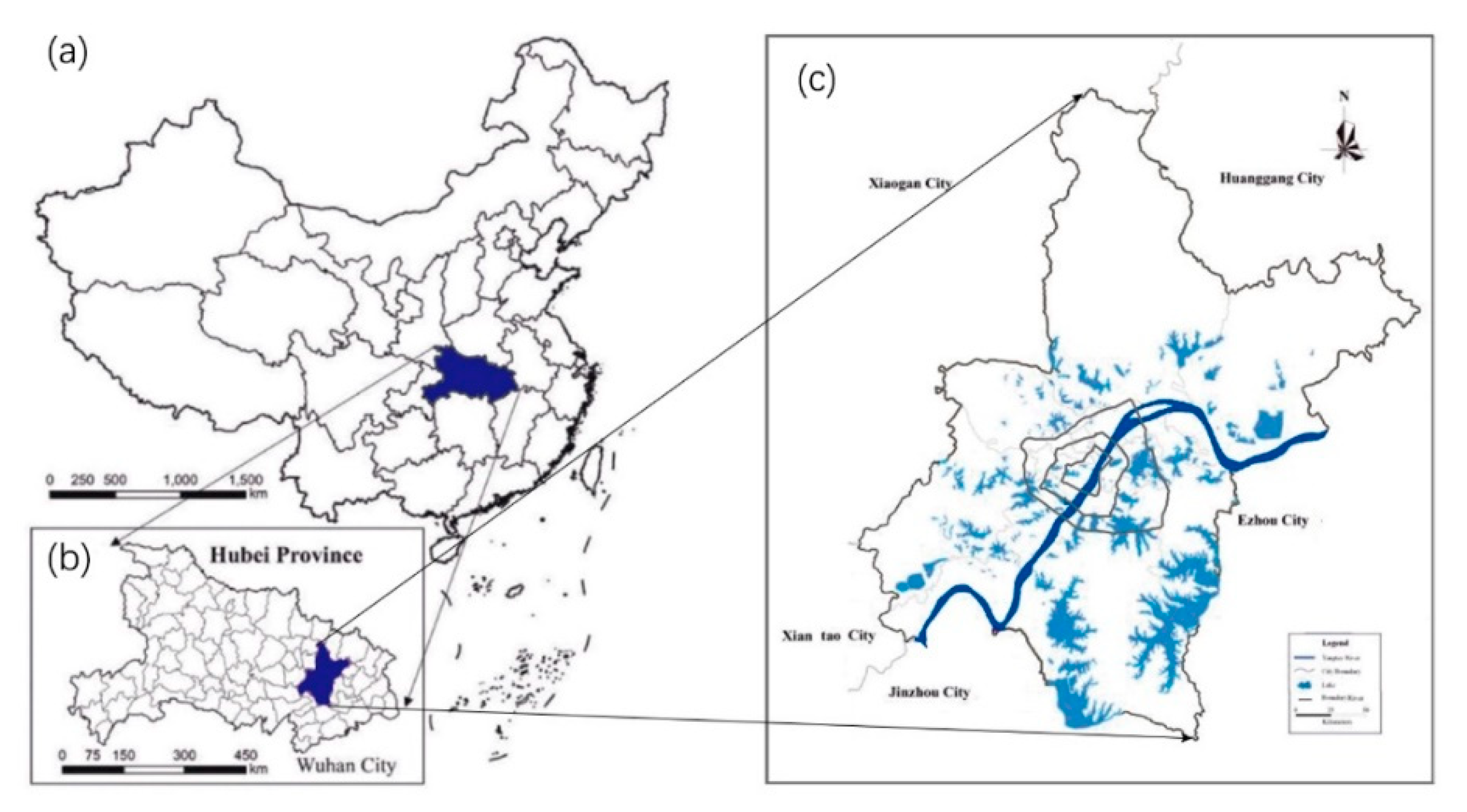
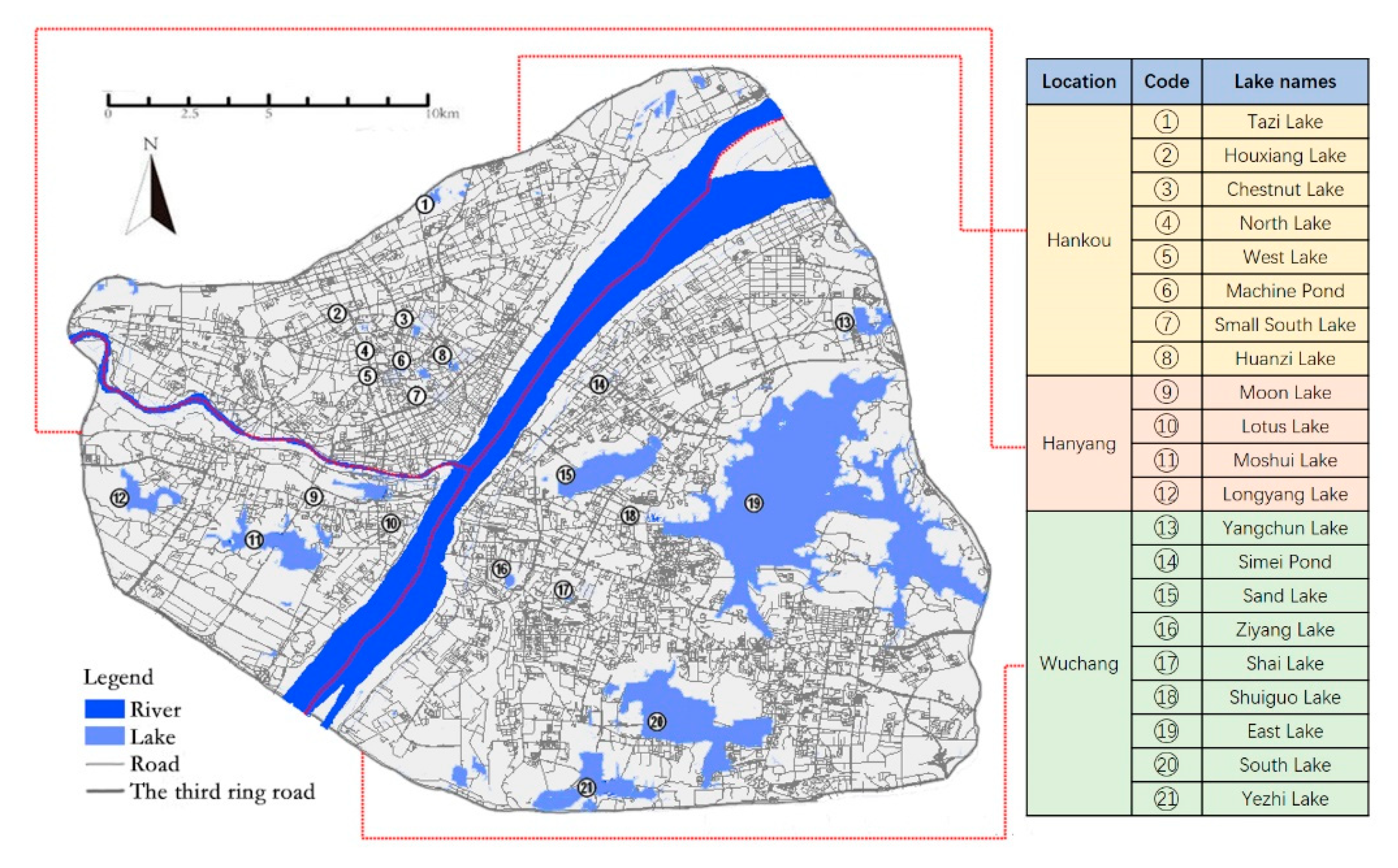

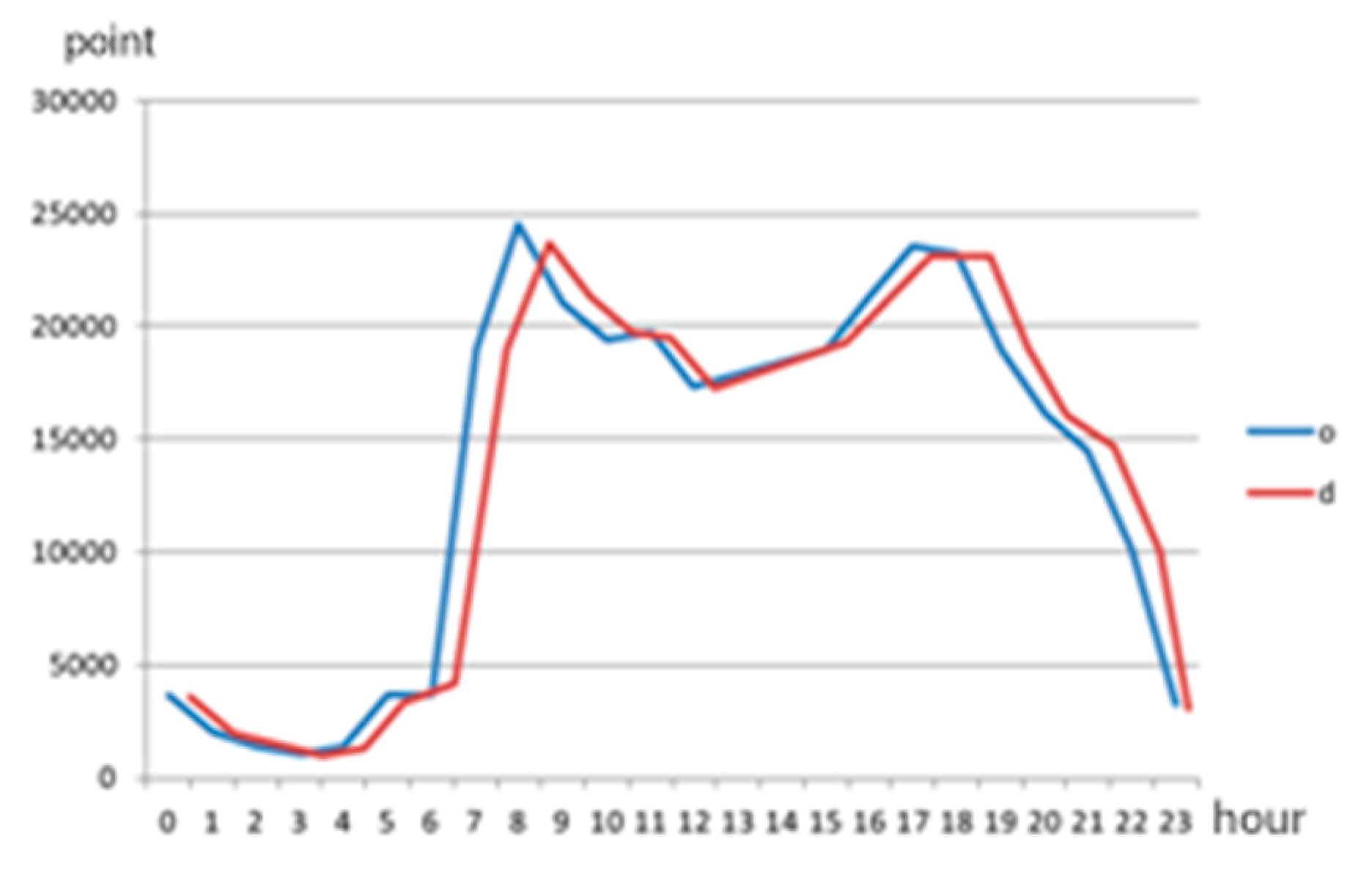


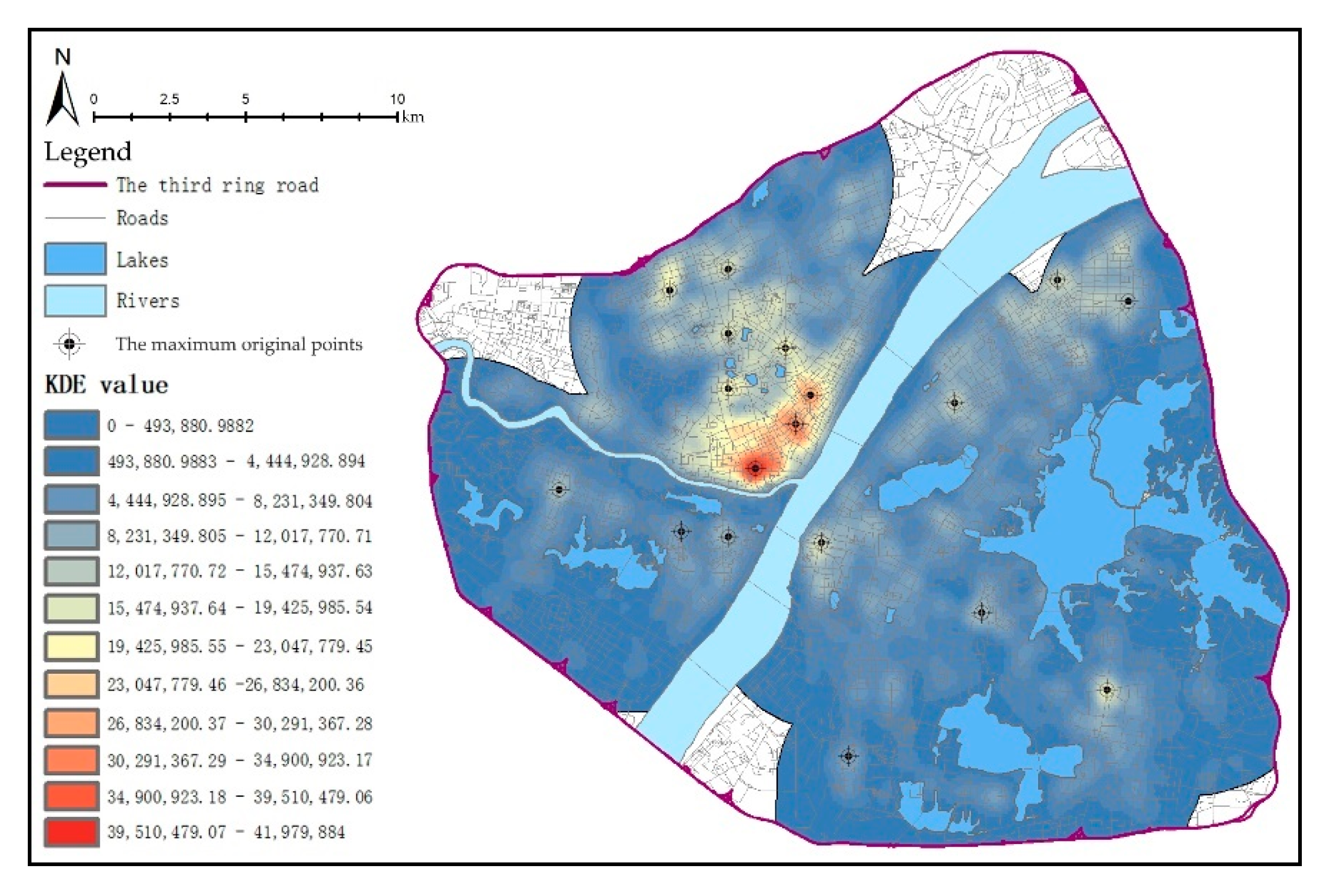

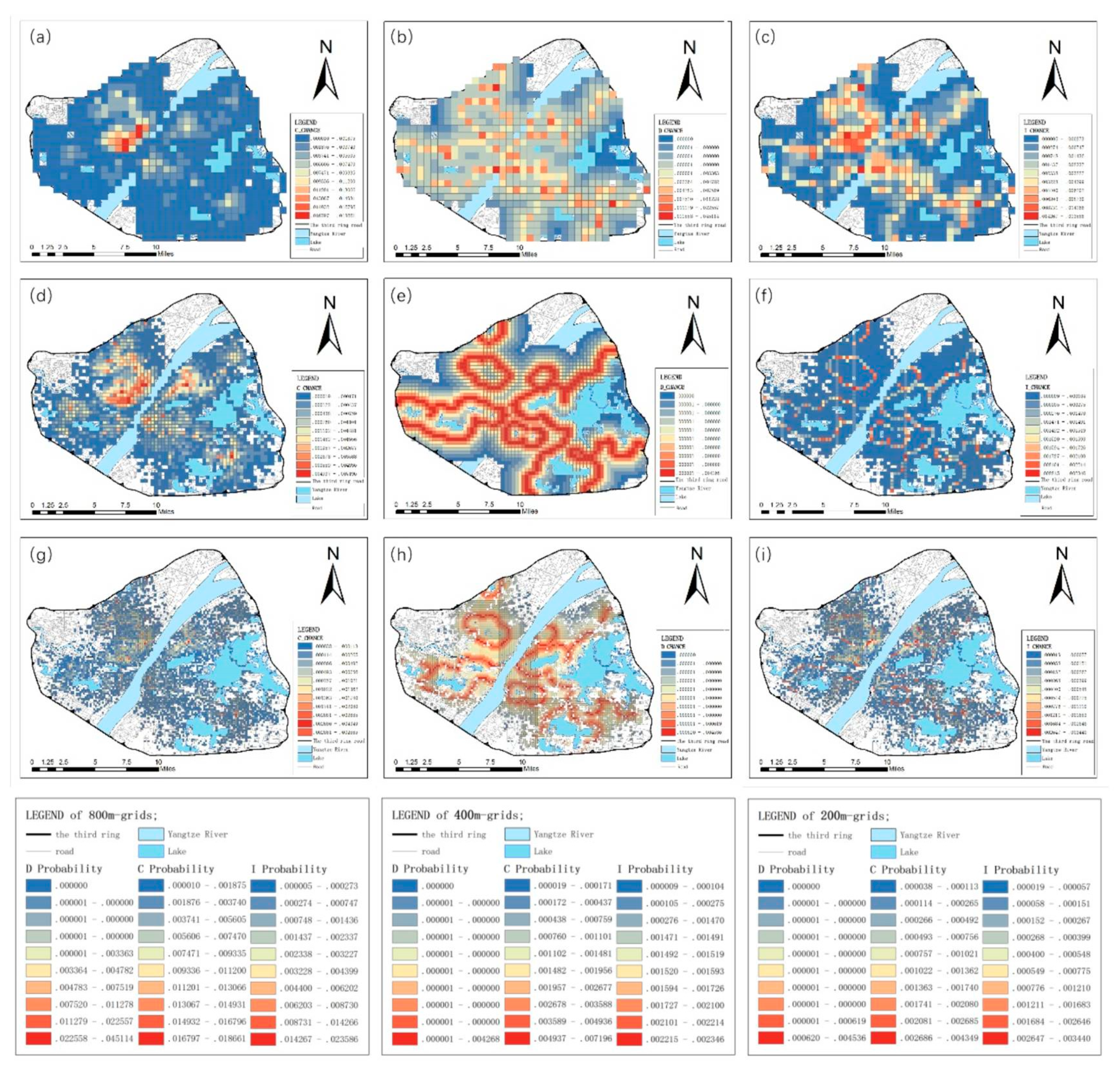

| Satellite | Sensor | Resolution(m) | Data Identification | Date | Cloudage (%) |
|---|---|---|---|---|---|
| Landsat 8 | OLI | 30/15 | LC81230392017303LGN00 | 2017/10/30 | 0.02 |
| Bike_id | Local_Time | Latitude | Longitude |
|---|---|---|---|
| 0276532421# | 2018–10-1 0:00:02 | 113.961279647370 | 30.4491527832408 |
| 0276011931# | 2018–10-5 9:15:03 | 114.005071163130 | 30.6456270970435 |
| … | … | … | … |
| Bike_id | Start_time | Start_lat | Start_lon | End_Time | End_lat | End_lon |
|---|---|---|---|---|---|---|
| 7550019867 | 20181001101213 | 114.279729 | 30.583554 | 20181001121123 | 114.267230 | 30.581205 |
| 7550021303 | 20181001103107 | 114.276460 | 30.571984 | 20181001115844 | 114.281483 | 30.570500 |
| … | … | … | … | … | … | … |
| Sand Lake | Ziyang Lake | Shai Lake | Shuiguo Lake | Simei Pond | East Lake | Moon Lake | |
| O Points | 110,718 | 37,238 | 41,474 | 18,680 | 39,484 | 99,631 | 53,907 |
| D Points | 82,188 | 29,234 | 33,342 | 14,590 | 31,224 | 99,172 | 41,883 |
| Differences | 28,530 | 8004 | 8132 | 4090 | 8260 | 459 | 12,024 |
| Lotus Lake | Moshui Lake | Longyang Lake | Yangchun Lake | Yezhi Lake | South Lake | Huanzi Lake | |
| O Points | 77,271 | 51,084 | 43,637 | 32,127 | 16,541 | 47,924 | 87,503 |
| D Points | 69,910 | 40,422 | 32,825 | 25,401 | 13,034 | 37,425 | 65,503 |
| Differences | 7361 | 10,662 | 10,812 | 6726 | 3507 | 10,499 | 22,000 |
| Tazi Lake | Small South Lake | Machine Pond | North Lake | Chestnut Lake | West Lake | Houxiang Lake | |
| O Points | 97,996 | 109,845 | 111,080 | 127,887 | 118,427 | 117,942 | 96,747 |
| D Points | 83,836 | 84,921 | 88,814 | 127,810 | 91,640 | 92,296 | 68,762 |
| Differences | 14,160 | 24,924 | 22,266 | 77 | 26,787 | 25,646 | 27,985 |
© 2019 by the authors. Licensee MDPI, Basel, Switzerland. This article is an open access article distributed under the terms and conditions of the Creative Commons Attribution (CC BY) license (http://creativecommons.org/licenses/by/4.0/).
Share and Cite
Wu, J.; Ling, C.; Li, X. Study on the Accessibility and Recreational Development Potential of Lakeside Areas Based on Bike-Sharing Big Data Taking Wuhan City as an Example. Sustainability 2020, 12, 160. https://doi.org/10.3390/su12010160
Wu J, Ling C, Li X. Study on the Accessibility and Recreational Development Potential of Lakeside Areas Based on Bike-Sharing Big Data Taking Wuhan City as an Example. Sustainability. 2020; 12(1):160. https://doi.org/10.3390/su12010160
Chicago/Turabian StyleWu, Jing, Changlong Ling, and Xinzhuo Li. 2020. "Study on the Accessibility and Recreational Development Potential of Lakeside Areas Based on Bike-Sharing Big Data Taking Wuhan City as an Example" Sustainability 12, no. 1: 160. https://doi.org/10.3390/su12010160
APA StyleWu, J., Ling, C., & Li, X. (2020). Study on the Accessibility and Recreational Development Potential of Lakeside Areas Based on Bike-Sharing Big Data Taking Wuhan City as an Example. Sustainability, 12(1), 160. https://doi.org/10.3390/su12010160




